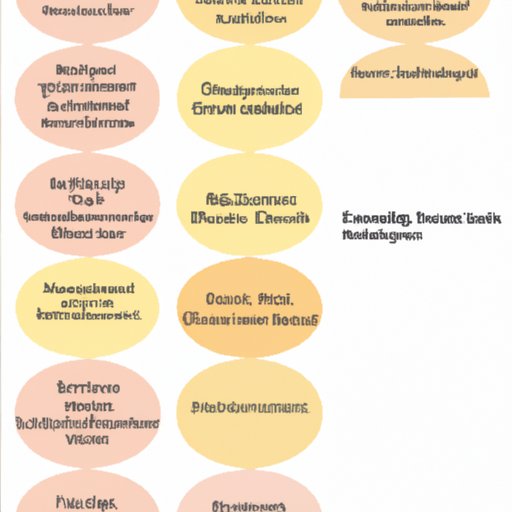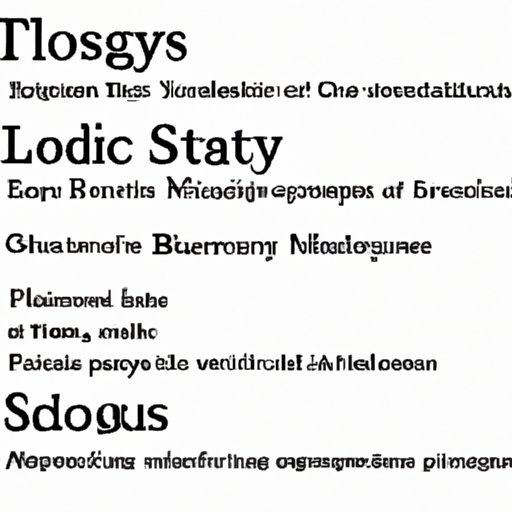Introduction
The term “soliloquy” comes from the Latin words “solus” meaning “alone” and “loqui” meaning “to speak”. It is an act of speaking one’s thoughts aloud when by oneself or regardless of any hearers, and is often found in dramatic works. In literature, a soliloquy is a speech given by a character that is alone on stage, or believes himself to be alone, revealing his innermost thoughts and feelings to the audience. The purpose of a soliloquy is to reveal the character’s true emotions and motivations, which are often hidden from other characters.
This article aims to provide a comprehensive guide to soliloquies in literature. It will explore what a soliloquy is, the types of soliloquies, examples of famous soliloquies, and the role of soliloquy in literature. Additionally, it will analyze the power of soliloquy in classic plays, discuss how soliloquies enhance literary texts, and understand the significance of soliloquies in dramatic works. Finally, it will provide tips for crafting an effective soliloquy.

A Comprehensive Guide to Soliloquies in Literature
What is a Soliloquy?
A soliloquy is a long monologue spoken by a single character in a play or other work of literature. It is usually used to express a character’s innermost thoughts and feelings, which may be hidden from other characters in the story. Soliloquies are often used to advance the plot and to give insight into the character’s feelings or motivations.
Types of Soliloquies
Soliloquies can be divided into two broad categories: interior soliloquies and exterior soliloquies. Interior soliloquies are those in which a character speaks to him or herself, while exterior soliloquies are those in which a character speaks to another character or the audience. Additionally, soliloquies can be divided into four distinct types: reflective, deliberative, passionate, and narrative.
Reflective soliloquies are used to explore a character’s feelings and motivations. Deliberative soliloquies are used to consider the pros and cons of a decision. Passionate soliloquies are used to express strong emotions such as anger, fear, or grief. Narrative soliloquies are used to provide background information and to explain past events.
Examples of Famous Soliloquies
Perhaps the most famous soliloquy in literature is the “To be or not to be” speech from William Shakespeare’s Hamlet. In this soliloquy, Hamlet contemplates life and death and struggles with the idea of suicide. Another famous example is Macbeth’s “Tomorrow and tomorrow and tomorrow” soliloquy, in which he reflects on the futility of life and his own mortality.
In addition to these two famous examples, there are many other soliloquies throughout literature. For instance, in F. Scott Fitzgerald’s The Great Gatsby, Daisy delivers a soliloquy about her feelings for Gatsby. Similarly, in J.D. Salinger’s The Catcher in the Rye, Holden Caulfield delivers a soliloquy about his longing for innocence.
Exploring the Role of Soliloquy in Literature
The Function of Soliloquy
Soliloquies are an important tool for writers, as they allow characters to directly address the audience and express their innermost thoughts and feelings. By providing insight into a character’s mind, soliloquies can help to advance the plot and provide additional context. They can also be used to create suspense or to set up a surprise ending.
How Soliloquies Affect Character Development
Soliloquies can also be used to develop characters and to reveal their motivations. Through a soliloquy, a character can reveal their feelings and desires, which can help to shape the audience’s understanding of them. Soliloquies can also be used to show how a character has changed over the course of the story.

Analyzing the Power of Soliloquy in Classic Plays
How Soliloquies Reveal Inner Thoughts
Soliloquies are particularly powerful in classic plays, as they allow characters to directly address the audience and share their innermost thoughts and feelings. By providing insight into a character’s mind, soliloquies can help to create a deeper understanding of the story. Additionally, soliloquies can be used to foreshadow events or to provide clues to the audience.
How Soliloquies Impact the Audience
Soliloquies can also be used to manipulate the audience’s emotions. By expressing a character’s innermost thoughts and feelings, a soliloquy can evoke empathy from the audience, allowing them to connect with the character on a deeper level. Additionally, soliloquies can be used to create tension or to heighten suspense.
How Soliloquies Enhance Literary Texts
Benefits of Using Soliloquies
Soliloquies are an effective tool for writers, as they allow characters to directly address the audience and reveal their innermost thoughts and feelings. Soliloquies can be used to advance the plot, to provide insight into a character’s motivations, and to create tension or suspense. Additionally, soliloquies can be used to evoke emotion from the audience and to create a deeper connection between the character and the reader.
Ways to Make Soliloquies More Effective
Soliloquies can be made more effective by using language that is specific and vivid. Additionally, soliloquies should be crafted in a way that reveals something new about the character and advances the plot. Writers should also pay attention to the length of the soliloquy and make sure that it does not drag on too long.
The Art of Crafting an Effective Soliloquy
Tips for Writing a Successful Soliloquy
When crafting a successful soliloquy, writers should keep the following tips in mind:
- Be specific and vivid in your language.
- Reveal something new about the character.
- Advance the plot.
- Pay attention to the length of the soliloquy.
- Focus on the character’s emotions.
- Create tension or suspense.
Elements of a Well-Written Soliloquy
A well-written soliloquy should include the following elements:
- Specific and vivid language.
- New insights into the character.
- Tension or suspense.
- A clear structure.
- An emotional impact.

Understanding the Significance of Soliloquies in Dramatic Works
Why Soliloquies are Important
Soliloquies are an essential part of dramatic works, as they allow characters to directly address the audience and share their innermost thoughts and feelings. By providing insight into a character’s mind, soliloquies can help to advance the plot and provide additional context. Additionally, soliloquies can be used to evoke emotion from the audience and to create a deeper connection between the character and the reader.
Examples of the Use of Soliloquy in Dramatic Works
Soliloquies are a common feature in dramatic works, and have been used for centuries. Some famous examples include:
- Hamlet’s “To be or not to be” soliloquy (William Shakespeare)
- Macbeth’s “Tomorrow and tomorrow and tomorrow” soliloquy (William Shakespeare)
- Daisy’s soliloquy (F. Scott Fitzgerald)
- Holden Caulfield’s soliloquy (J.D. Salinger)
Conclusion
Summary of Key Points
This article provided a comprehensive guide to soliloquies in literature. It explored what a soliloquy is, the types of soliloquies, examples of famous soliloquies, and the role of soliloquy in literature. Additionally, it analyzed the power of soliloquy in classic plays, discussed how soliloquies enhance literary texts, and understood the significance of soliloquies in dramatic works. Finally, it provided tips for crafting an effective soliloquy.
Final Thoughts
Soliloquies are an important tool for writers, as they allow characters to directly address the audience and reveal their innermost thoughts and feelings. By providing insight into a character’s mind, soliloquies can help to advance the plot and provide additional context. Additionally, soliloquies can be used to evoke emotion from the audience and to create a deeper connection between the character and the reader.
(Note: Is this article not meeting your expectations? Do you have knowledge or insights to share? Unlock new opportunities and expand your reach by joining our authors team. Click Registration to join us and share your expertise with our readers.)
